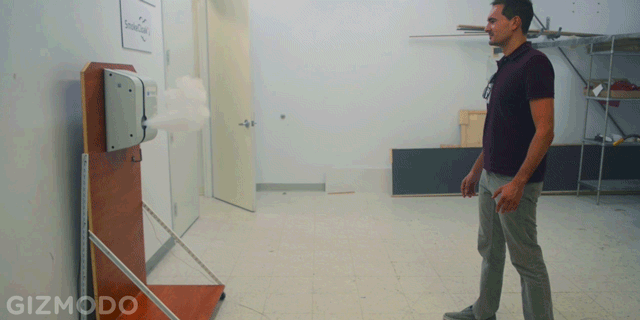What you’re looking at is me, being blasted by a fog machine. It’s not a prop for a rave or a haunted house; it’s vapor laced with custom DNA particles that could prove I was at the scene of a crime. And it’s just one way a cutting-edge security firm is using life’s building blocks to detect counterfeits and bust criminals.
I had a chance to visit Applied DNA Sciences, a biotechnology-based security company at Stony Brook University, about an hour east of New York City. Here, scientists and security experts have figured out how to tweak custom-engineered strands of DNA derived from plants to make what they say are unfakeable identification tags.
There are lots of reasons you’d want infallible proof a product (or person) is legit. High-end clothing and gadget makers are combating a market flooded with knockoffs. People are getting increasingly good at forging paper tickets to events. The US military has discovered an astounding number of counterfeit electronic components in warplanes — parts crucial for night vision and missile guidance equipment that came from who-knows-where, and whose failure would put lives in danger.
Yet, today’s standard anti-counterfeiting methods — hologram stickers, specialised inks, hidden branding marks and other identifying tags used in industrial production — aren’t nearly as secure as manufacturers like to think. Given enough financial incentive, a fake-maker will find a way to copy your mark.
The team at ADNAS set out to create a marker that can’t be forged or reverse-engineered no matter how advanced the counterfeiter, and can also be used to definitively indicate whether a suspect was at the scene of a crime. The secret sauce? DNA, the building blocks for all biological life. And I got to see how the process works.
DNA: Not just for cells anymore
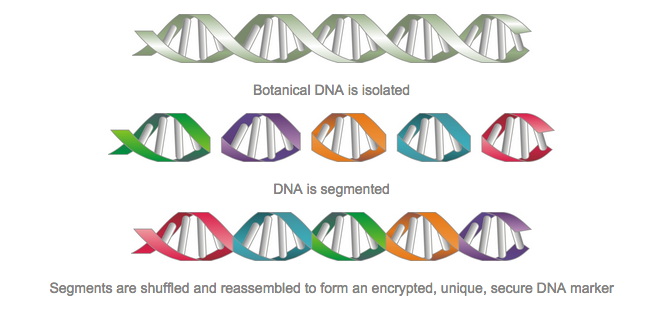
How ADNAS creates novel DNA sequences from natural plant DNA. Credit: ADNAS
Scientists at the lab start with known sequences of DNA from plants, chop them up into short segments, and rearrange those segments to create unique sequences. That custom DNA is then incorporated into tags embedded in tiny materials like microchips, permanent ink pens used to mark personal items, or the fog juice inside an industrial smoke machine.
Let’s get into that smoke machine for a second. It’s full of the lab’s proprietary SigNature DNA-powered tag, and can be connected to a building’s alarm system. So say someone’s trying to rob a jewelry store: When the alarm sounds, the fog machine fills the room with DNA-laced smoke that tags the intruder and anything he or she might grab. The tag doesn’t wash off, and that thick fog means the DNA gets everywhere, permeating a suspect’s clothes, hair, and skin, and loot. And that unique marker that could only have come from the scene of the crime.
When the cops catch up with the suspect, a UV flashlight will show the DNA spray glowing bright red on the suspect, and on anything he or she stole. From there, the authorities need only to take a swab and send it to the ADNAS lab, where scientists will confirm if the DNA sequence on the perp matches the one in the business’s fog machine.
In order to understand what the lab does with just a few billion strands of DNA, we should first crank out a hasty review of how DNA works. Double-stranded DNA’s basic structure is a ladder, as shown below:

Picture: BBC
In a living cell, DNA replicates by first “unzipping” into single strands. The strands can only be copied in one direction, a process that starts when a piece called the primer binds to the beginning of the strand. This primer can only bind if it’s got the exact sequence needed to match up with the existing strand. Once the primer binds, the replication machinery kicks in, copying the sequence.
In other words, without the primer, you can’t copy the DNA — and ADNAS keeps every primer for the sequences it creates under lock and key.
“They categorically cannot be copied,” Dr James Hayward, president and CEO of ADNAS boasted during my visit to the company’s lab. Now, of course a CEO is going to say its product is fool-proof, but that claim held up after vetting by the U.S. Department of Defence. When the combined knowledge of Battelle Laboratories and the American National Laboratory System could not successfully copy ADNAS’s mark, or even transfer it from one device to another, the DOD signed a contract with the company.
To what end? The Defence Department had recently discovered that the majority of electronic components in planes like the C-130 cargo-hauler and the Navy’s P-8A maritime patrol aircraft originated in Chinese knockoff factories. Now dozens of defence suppliers incorporate ADNAS tags in their products. Adding the DNA tag to a mass-produced item, Hayward tells me, is easy. “In the microelectronics, we have DNA in a particular kind of epoxy acrylate ink which is as hard as stainless steel.”
It’s just one of various applications of ADNAS’s SigNature DNA tag, which just recently became commercially available. There’s the aforementioned intruder-tagging DNA fog, QR code stickers printed with DNA ink, where the QR code is the first line of authenticity and the DNA is the second level of proof. The company also offers services for authenticating textiles, making sure that those expensive Egyptian cotton sheets really do contain the right proportion of top-quality Egyptian cotton.
Swabbing Science
So, say you’ve got a DNA-tagged microchip that you want to be sure is the real thing, or a suspect who may or may not have been blasted by DNA fog when your business’s alarm went off. How do you use the engineered DNA tag to settle it? The definitive answer is just a swab away at the lab.
Dr. Ila Lansky, senior forensic scientist at the lab, showed us how the company determines whether an item holds its DNA tag. For illustration, she used a bank note from the unknown nation of No Value, marked with ADNAS’s DNA-laced invisible ink marker — but the process is the same whether you’re identifying an electronic component, a valuable, or a suspected intruder.
The ink is nearly invisible to the naked eye, resembling clear nail polish in areas where it’s been piled onto an object in several coats:
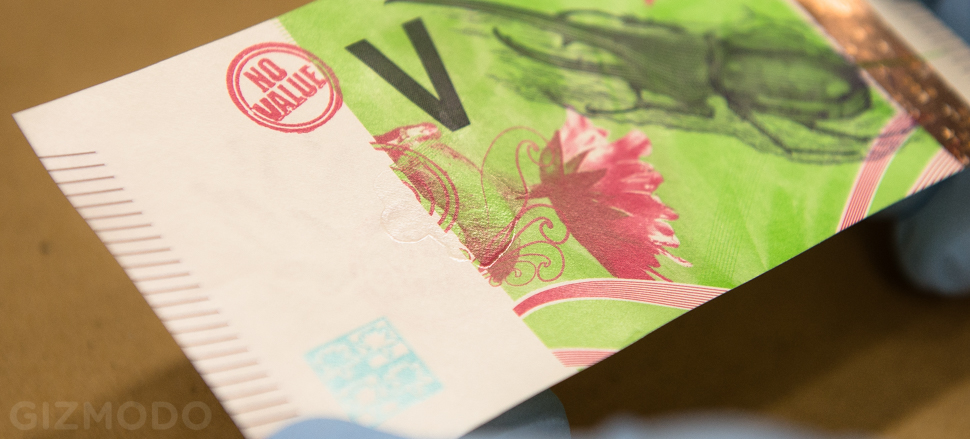
But under UV light, the ink shows up fluorescent orange to help scientists locate the tag:
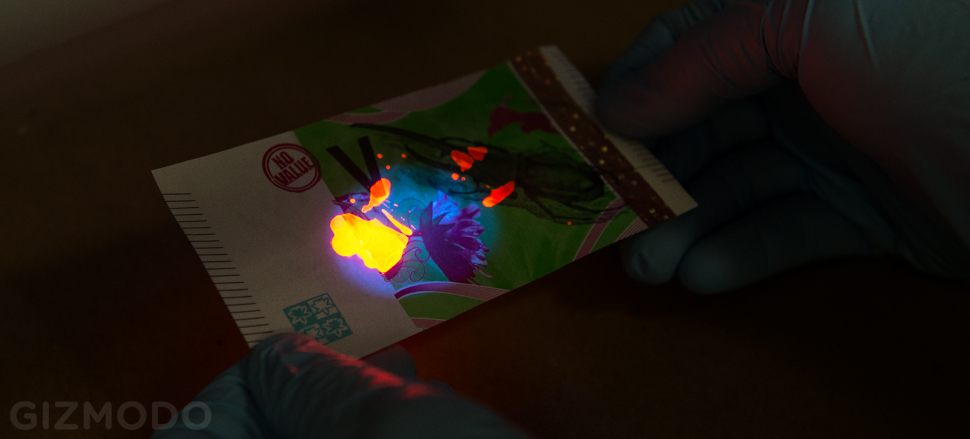
That UV glow serves as a quick and easy first-pass identifier: If it’s not where it should be, this ain’t the genuine item. ADNAS even has “encrypted” fluorescent inks, markers which only glow under UV light after being treated with a special chemical.
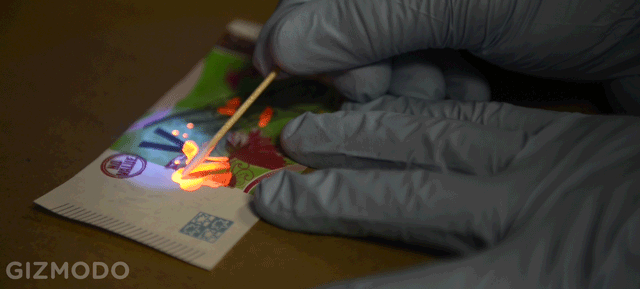
Even an infinitesimally small amount of DNA caught up in the fibres of the swab is enough for identification. The tip of the swab is cut off and placed in a reaction tube, and checked under UV light to make sure it glows with the transferred DNA marker.

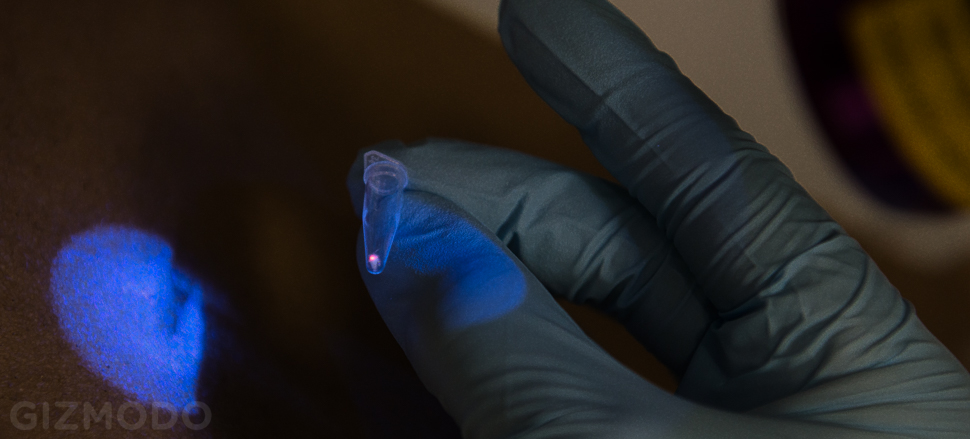
The minute scrape of DNA contained in that little glowing dot on that wee shred of cotton is more than enough for scientists to identify with PCR, a technique which can copy a single piece of DNA a million times in just one hour.
The necessary reacting agents are added to the test tube, and it’s placed in a DNA amplifying device to undergo polymerase chain reaction, or PCR, a common lab procedure that can create millions of identical copies of the target DNA from the swab.
Recall that ADNAS is the only party that can produce the primers needed to copy the DNA in the tag. If the primers in that tiny droplet don’t match up to the DNA on the swab, there will be no DNA replication. It’s a dud. If the proper DNA is present, however, its primer will bind, PCR will crank out millions of copies, and analysis of the DNA sample will confirm that the copies are identical to the DNA strand that indicates the tag is authentic.

That’s me play-acting science at the ADNAS lab. A real scientist, I’m assured, would have a lab coat with long enough sleeves to prevent cross-contamination from errant arm-hairs.
You may be thinking that DNA sequencing is proven technology; current devices do it fast, and future techniques promise sequencing in minutes, nay, seconds. An enterprising fake-house, you would imagine, could invest in some not-uncommon research lab equipment and start cranking out carbon copies of ADNAS sequences the same way ADNAS itself produces them.
ADNAS stacks the deck against that possibility in two ways. First, it can change the DNA sequence it puts in a customer’s tag pretty much on demand. For fog-based security systems, they recommend a yearly sequence switch. For industrial applications, the frequency is much higher. One customer, Hayward told us, wants a new DNA tag every hour, to serve as both a mark of authenticity and a serial number that can trace back to the individual production batch.
Second, ADNAS loads each tag with thousands of decoys, DNA strands with a sequence that’s entirely different from the target strand. Without the primer (which, again, ADNAS keeps under lock and key), a potential counterfeiter has no way of determining which of the DNA sequences in the tag is legit.
DNA in your pills and printers
Right now, ADNAS doesn’t make any money. Hayward freely admitted this to me in our conversation. That’s not stopping the 55-person company from embedding its custom-engineered DNA in consumer and industrial products all over the place. It’s looking to make its DNA-laced products even more scalable, loading DNA ink into industrial production lines and inkjet printers alike.
The company would not release the names of its customers, but did tell me that an entire arm of ADNAS is dedicated to the textile trade, authenticating premium materials and helping brands trace the adulterated or fraudulent products that masquerade as the real thing in the marketplace.
Scientists are even looking at ways of using DNA tags to authenticate individual pills, to combat the counterfeit medications that plague places like South Africa, where the market is bogged down with ineffective knockoffs of the pharmaceuticals used to treat malaria.
For that to work, you’d need one piece of equipment that, at the moment, doesn’t exist: A portable DNA decoder that could verify ADNAS tags in the field. Hayward says an in-field DNA detector is the company’s brass ring, and while he won’t give an ETA for such a device, he says they’re close to cracking it.
It’s hard to believe a man who says his company has devised an identifying technology that “cannot be copied,” full stop. I have no way of predicting whether that will pan out to be true. But from what I saw touring the biotech forensics lab, the technology really is remarkable. Life’s genetic code may actually start to make life more secure.
Pictures: Nicholas Stango
